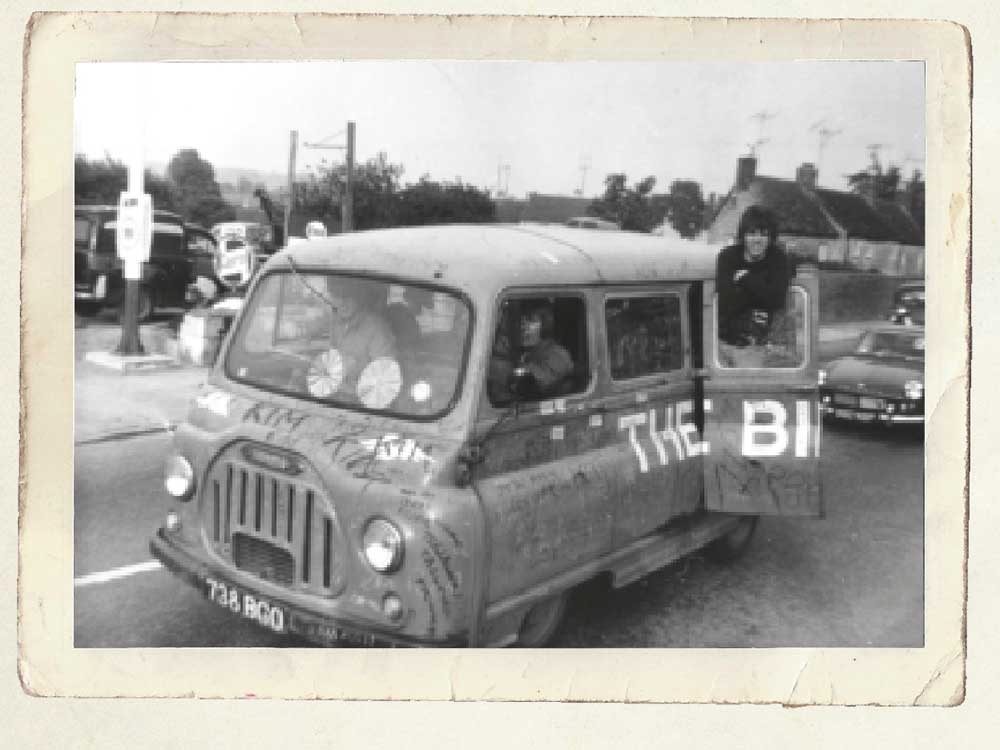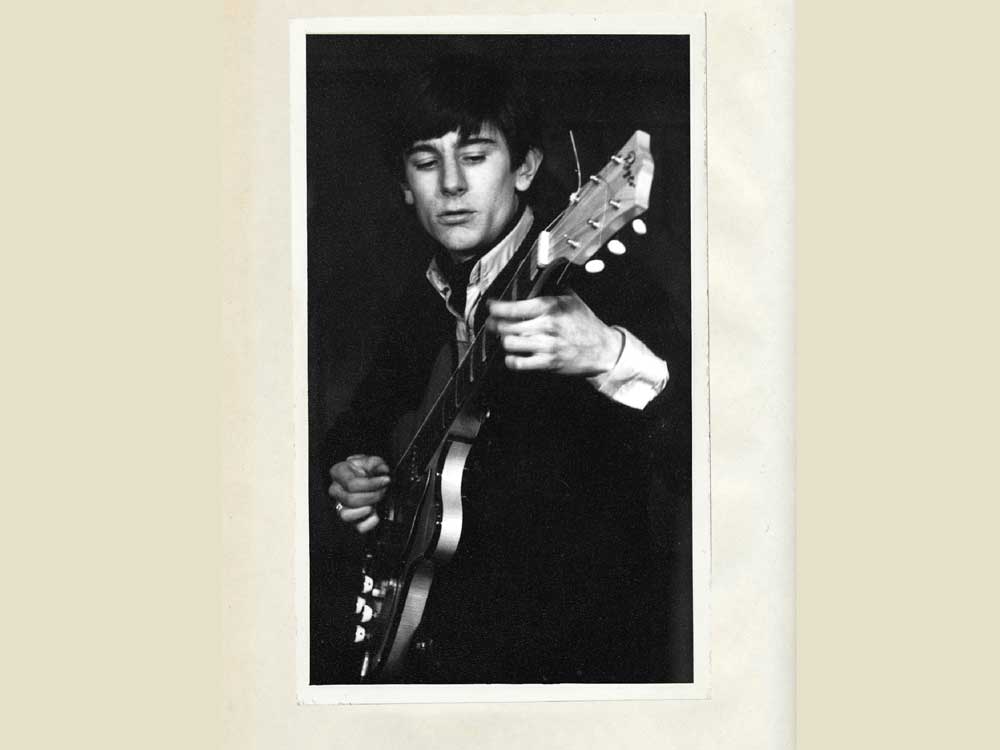Ronnie Wood interview: dear diary
Life before he was a Face

Ronnie Wood: How Can It Be?
Rewind the tape half a century or so to 1965 and Ronnie Wood was the guitarist in West London R&B combo The Birds – not to be confused with American West Coast folk-rockers The Byrds, though there was some considerable legal wrangling when Roger McGuinn et al arrived on British shores in the spring of 1965.
“To actually sit down and write, it’s a lost art isn’t it?”
The Birds with an ‘i’ were a popular live draw in various corners of the UK despite, in Wood’s words, “always suffering” because they never had a hit single. And it’s this formative musical period – in many ways an apprenticeship for what would come later – that Wood recalls fondly as we sit in conversation in The Rolling Stones’ London offices.
Wiry, animated, and powered by Marlboro Golds throughout our interview, the Stones guitarist is here to talk about his latest book, How Can It Be? A Rock & Roll Diary, which reprints and annotates the journal that the 17-year-old Wood kept in 1965 while clocking up thousands of road miles and encountering the likes of Eric Clapton and Keith Moon along the way. In the age of social media, it’s rare that any modern teenager would put pen to paper in such a regimented manner.
“To actually sit down and write, it’s a lost art isn’t it?” Wood agrees. “They do it all on their laptop and their phone.” Yet back when London swung, there was much for the teenage guitarist to record for posterity: “There was a lot of camaraderie, really. We were all struggling the same way, all doing the circuit, ploughing up and down the lengths of England, starting out of London and then going out into the sticks.
"The Birds were always suffering from never having a hit record. If we got in the Top 50 it was like, ‘Wow, this is amazing’, because so much stemmed from being in the charts in those days. Whereas The Who would have a No 1 and they’d be in the audience at The Ealing Club going ‘We’re number one,’ and we’re going, ‘You bastards!’.
“Moonie would get up and play with us, which really meant a lot. He also came over to my mum’s when I was living with her. I grew up around London Airport way in a little council house with Keith Moon coming over! Mum and dad were in bed, but he’d be there the next morning on the sofa or something. Or Mitch Mitchell.
It was an honour to have these guys over. We knew they were doing something good, and they knew I was doing something good, but they would all take me under their wing and say, ‘Come on Ron, keep it up. You’ll be there one day’.
Little Ronnie
“I was always younger than these guys, especially the guys that had made it. Eric [Clapton] was a bit older than me. John Mayall, Zoot Money, Georgie Fame and The Stones were that bit older. Later on, when I met Rod Stewart, he was a few years older than me. I always was the youngest and I used to think, ‘Well, my time will come’.
"Always the driving force is the music and trying to get better and striving to get better"
"And the energy that is in this diary is of totally non-stop hard work, every day of the week, and the girls coming and going, but always the driving force is the music and trying to get better and striving to get better. The same as the art, I always did that as well. So it was nice to find [the diary]. I couldn’t believe it was 50 years ago.”
How Can It Be? A Rock And Roll Diary by Ronnie Wood, the signed limited-edition book of 1,965 copies, is available to order fromwww.ronniewoodbook.com

Who Came First?
How Can It Be? also contains plenty of references to the equipment Wood was using at the time, including a Strat and a Telecaster that he decorated, Pop Art-style, and modified.
“The Tele I used with The Birds – I’ve just remembered this – I resprayed the body and put another neck on, a 12-string neck, so it became a 12-string. I’ve lost it now, but it was a great sound.”
Interestingly, Wood’s diary entry for 24 September, 1965 sees him celebrate the arrival of a 100-watt Marshall head and an 8x12 speaker cabinet with “a knockout sound”.
The date is significant; guitar folklore and Jim Marshall’s own recollections credit Pete Townshend as the driving force behind the design of the Marshall 8x12, its angled front section for the top speaker pair providing the blueprint for the iconic look of the Marshall stack that followed.
Stack race
Townshend had already ‘stacked’ one Marshall 4x12 on top of another beneath his blonde 1964 Fender Bassman head in pursuit of a more imposing backline. But two weeks after receiving his 8x12 cabinets in early November 1965 (their first known live use was 13 November at La Locomotive Club, Paris),
"[Pete Townshend] was trying to get one made, but I had mine and he actually saw it in the shop. He was advanced on everything else, but I happened to beat him to this special cabinet."
The Who’s guitarist asked Jim Marshall if they could be cut in half as they were so unwieldy – not to mention hard to topple during the band’s riotous concert finales – and it’s this moment that’s widely credited as the true birth of the Marshall stack. Indeed, the 1960A (angled top) and 1960B (flat base) would go into production by the end of the year.
However, Wood insists that his 8x12 was first: “Jim Marshall’s in Hanwell was a big hub. You’d meet other musicians in there. Me and Pete Townshend would have an ongoing friendly battle. He’d say, ‘I’ve just had this one made’. When I had my cab made with the eight 12-inch speakers in one cabinet, it was like, ‘You bastard’.
"He was trying to get one made, but I had mine and he actually saw it in the shop. He was advanced on everything else, but I happened to beat him to this special cabinet. He loved it, though, in the end. He has always been a great, supportive influence on me to this day.”

Smokestack Lightning
The 17-year-old Wood was embedded in a vibrant music scene, in which there was no shortage of onstage fireworks, as he explains: “Nobody ever bothered to actually get to the finer points of finding out if you were going to get an electric shock and things like that, and I did actually get electrocuted a few times on stage.
"Once I got sent flying right over the other side of the stage and sent to hospital and they said, ‘Well you’ve got a very strong heart, Mr Wood, you’ve got to go back and do a second set’"
"Once I got sent flying right over the other side of the stage and sent to hospital and they said, ‘Well you’ve got a very strong heart, Mr Wood, you’ve got to go back and do a second set’. So I did. I had burnt hands.”
It’s the kind of resilience that would undoubtedly help Wood when he joined The Rolling Stones: “Keith was telling me he did that, too, he got shocked as well like that, 240 volts! You know you got it. So, actually, [never mind the] finer points of sound, you were just lucky to find a socket to get plugged in.”
Madchester
That said, his experiences in The Birds did give Ronnie “a taste” of what would come later during his time with The Faces and The Stones. “Going down to Salisbury, it would be Dave Dee, Dozy, Beaky, Mick & Tich, they were really big down there, and The Birds.
"For some strange reason, the girls would go nuts and pull their hair and try and get your clothes and pieces of you. There was a little bit of that around Manchester, they used to love us up there.
"There were some dodgy areas. I remember Stratford-upon-Avon"
“Then you’d get more fearful for your life as you went into Scotland, towards Glasgow, you were lucky to get out of there alive. We got out of there alive, so we survived and we didn’t get any bottles thrown at us. I saw really terrible things, blood, you know; terrible things happening up there.
"There were some dodgy areas. I remember Stratford-upon-Avon, getting out of there by the skin of our teeth. The terrible rockers used to come out with gangs, they used to just set on any strangers, it was horrible. Leeds was pretty hard going, and strange areas by the seaside: Blackpool, Cleethorpes… barren, lonely, freezing times, up there with Dave Berry.
"He had a hit record, but we were up on the bill with him. It was just such an adventure all the time and you’re young enough for it all to bounce off – all of the hard work and the not so glamorous side – and get through it all.”

Then And Now
All the time, Wood was unconsciously developing an approach to the guitar that would serve him well as Keith Richards’ co-conspirator in what Richards refers to as the “ancient art of weaving”: “It’s very unclear to me exactly what I was doing on the guitar in 1965. I enjoyed playing with another guitar player.
"I say, ‘Was it loud enough tonight?’ He says, ‘Yes, the paint was peeling from the ceiling’"
"Tony [Munroe, guitar/vocals] was a rhythm player and I was the lead. I’d have certain parts that I’d play, but I’d always weave with the vocals. I’d learn from records from Chuck Berry, from Howlin’ Wolf, Jimmy Reed, Muddy Waters, whoever it may be. The Beach Boys, whatever it was, all piled into a melting pot.
“It was all melded together from an early jazz thing through Louis Armstrong and Bix Beiderbecke. My brother, Ted, he had all the jazz side, which would weave together with blues and R&B and the Motown and the soul. It was a great way to shape what eventually came out as my own approach. I didn’t know it at the time!”
Killer guitars
Wood has owned some killer guitars over the years, and his latest squeeze is a heavily modified 1970s Les Paul Goldtop: “I always thought they were too heavy before, I always left them to other people, but I’m really getting off on it. I’ve had it adapted.
"I’ve had a little hole drilled in the top for my slide so I can get it quickly and Mick Taylor doesn’t nick it. If I put it down, it’s gone, Mick Taylor’s got it! I’ve had the toggle removed because when you’re strumming you always knock it.
"Pierre de Beauport found it, our roadie. He said, ‘I’ve found this. I’m not quite sure what year it is’. It didn’t matter. I just loved the neck on it. I put a pad on it because they cut into you. They’re so heavy; they cut into your ribs, so I got a soft thing so it would bounce on your body.”
And when it comes to playing live, there’s no need for an 8x10 cabinet. Wood uses “just [Fender] Twins basically. One Twin, and maybe a Boogie, but Dave [Natale] who does the sound out front, he’s brilliant because you only need a little amp on the stage and he makes it like a mountain.
"It peels the lacquer off peoples’ teeth. I say, ‘Was it loud enough tonight?’ He says, ‘Yes, the paint was peeling from the ceiling’.”
Chris Vinnicombe worked with us here on the MusicRadar team from the site's initial launch way back in 2007, and also contributed to Guitarist magazine as Features Editor until 2014, as well as Total Guitar magazine, amongst others. These days he can be found at Gibson Guitars, where he is editor-in-chief.

